Magnetic Nanoparticles Functionalized Few-Mode-Fiber-Based Plasmonic Vector Magnetometer
Abstract
1. Introduction
2. Principles and Structure
3. Fabrication and Characterization
4. Experiments and Results
4.1. Experimental Setup
4.2. Response to Magnetic-Field Orientation
4.3. Response to Magnetic-Field Intensity
4.4. Control Experiment
4.5. Discussion
5. Conclusions
Author Contributions
Funding
Conflicts of Interest
References
- Zhao, Y.; Liu, X.; Lv, R.-Q.; Zhang, Y.-N.; Wang, Q. Review on Optical Fiber Sensors Based on the Refractive Index Tunability of Ferrofluid. J. Lightwave Technol. 2017, 35, 3406–3412. [Google Scholar] [CrossRef]
- Clark, N.A. Soft-matter physics: Ferromagnetic ferrofluids. Nature 2013, 504, 229. [Google Scholar] [CrossRef]
- Yusuf, N.A. Field and concentration dependence of chain formation in magnetic fluids. J. Phys. D Appl. Phys. 1989, 22, 1916. [Google Scholar] [CrossRef]
- Torres-Díaz, I.; Rinaldi, C. Recent progress in ferrofluids research: Novel applications of magnetically controllable and tunable fluids. Soft Matter 2014, 10, 8584. [Google Scholar] [CrossRef] [PubMed]
- Sun, B.; Fang, F.; Zhang, Z.; Xu, J.; Zhang, L. High-sensitivity and low-temperature magnetic field sensor based on tapered two-mode fiber interference. Opt. Lett. 2018, 43, 1311–1314. [Google Scholar] [CrossRef]
- Zu, P.; Chan, C.C.; Lew, W.S.; Jin, Y.; Zhang, Y.; Liew, H.F.; Chen, L.H.; Wong, W.C.; Dong, X. Magneto-optical fiber sensor based on magnetic fluid. Opt. Lett. 2012, 37, 398–400. [Google Scholar] [CrossRef] [PubMed]
- Chen, Y.; Han, Q.; Liu, T.; Lan, X.; Xiao, H. Optical fiber magnetic field sensor based on single-mode-multimode-single-mode structure and magnetic fluid. Opt. Lett. 2013, 38, 3999–4001. [Google Scholar] [CrossRef]
- Mahmood, A.; Kavungal, V.; Ahmed, S.S.; Farrell, G.; Semenova, Y. Magnetic-field sensor based on whispering-gallery modes in a photonic crystal fiber infiltrated with magnetic fluid. Opt. Lett. 2015, 40, 4983–4986. [Google Scholar] [CrossRef]
- Yu, Z.; Jiang, J.; Zhang, X.; Liu, K.; Wang, S.; Chen, W.; Liu, T. Fiber Optic Magnetic Field Sensor Based On Magnetic Nanoparticle Assembly In microcapillary ring resonator. IEEE Photonics J. 2017, 9, 1–9. [Google Scholar] [CrossRef]
- Liu, T.; Chen, Y.; Han, Q.; Lu, X. Magnetic Field Sensor Based on U-Bent Single-Mode Fiber and Magnetic Fluid. IEEE Photonics J. 2014, 6, 1–7. [Google Scholar] [CrossRef]
- Chen, Y.; Liu, T.; Han, Q.; Yan, W.; Yu, L. Fiber loop ring-down cavity integrated U-bent single-mode-fiber for magnetic field sensing. Photonics Res. 2016, 4, 322–326. [Google Scholar] [CrossRef]
- Luo, L.; Pu, S.; Tang, J.; Zeng, X.; Lahoubi, M. Reflective all-fiber magnetic field sensor based on microfiber and magnetic fluid. Opt. Express 2015, 23, 18133–18142. [Google Scholar] [CrossRef] [PubMed]
- Liu, H.; Zhang, H.; Liu, B.; Song, B.; Wu, J.; Lin, L. Ultra-sensitive magnetic field sensor with resolved temperature cross-sensitivity employing microfiber-assisted modal interferometer integrated with magnetic fluids. Appl. Phys. Lett. 2016, 109, 042402. [Google Scholar] [CrossRef]
- Li, Z.; Liao, C.; Song, J.; Wang, Y.; Zhu, F.; Wang, Y.; Dong, X. Ultrasensitive magnetic field sensor based on an in-fiber Mach–Zehnder interferometer with a magnetic fluid component. Photonics Res. 2016, 4, 197–201. [Google Scholar] [CrossRef]
- Liang, H.; Liu, Y.; Li, H.; Han, S.; Zhang, H.; Wu, Y.; Wang, Z. Magnetic-ionic-liquid-functionalized photonic crystal fiber for magnetic field detection. IEEE Photonics Technol. Lett. 2018, 30, 359–362. [Google Scholar] [CrossRef]
- Gao, R.; Jiang, Y.; Abdelaziz, S. All-fiber magnetic field sensors based on magnetic fluid-filled photonic crystal fibers. Opt. Lett. 2013, 38, 1539–1541. [Google Scholar] [CrossRef]
- Chen, Y.; Han, Q.; Liu, T.; Yan, W.; Yao, Y. Magnetic Field Sensor Based on Ferrofluid and Photonic Crystal Fiber With Offset Fusion Splicing. IEEE Photonics Technol. Lett. 2016, 28, 2043–2046. [Google Scholar] [CrossRef]
- Deng, M.; Liu, D.; Li, D. Magnetic Field Sensor based on Asymmetric Optical Fiber Taper and Magnetic Fluid. Sens. Actuators A 2014. [Google Scholar] [CrossRef]
- Ma, R.; Kong, R.; Xia, Y.; Li, X.; Wen, X.; Pan, Y.; Dong, X. Microfiber polarization modulation in response to protein induced self-assembly of functionalized magnetic nanoparticles. Appl. Phys. Lett. 2018, 113, 033702. [Google Scholar] [CrossRef]
- Ma, R.; Li, X.; Dong, X.; Xia, Y.; Ma, R.; Li, X.; Dong, X.; Xia, Y.; Ma, R.; Li, X. Magnetic field modulating in-line fiber polarization modulator based on microfiber and magnetic fluid. Appl. Phys. Lett. 2017, 111, 093503. [Google Scholar] [CrossRef]
- Zhang, Z.; Guo, T.; Zhang, X.; Xu, J.; Xie, W.; Nie, M.; Wu, Q.; Guan, B.O.; Albert, J. Plasmonic fiber-optic vector magnetometer. Appl. Phys. Lett. 2016, 108, 289. [Google Scholar] [CrossRef]
- Yin, J.; Ruan, S.; Liu, T.; Jiang, J.; Wang, S.; Wei, H.; Yan, P. All-fiber-optic vector magnetometer based on nano-magnetic fluids filled double-clad photonic crystal fiber. Sens. Actuators B 2017, 238, 518–524. [Google Scholar] [CrossRef]
- Yin, J.; Yan, P.; Chen, H.; Yu, L.; Jiang, J.; Zhang, M.; Ruan, S. All-fiber-optic vector magnetometer based on anisotropic magnetism-manipulation of ferromagnetism nanoparticles. Appl. Phys. Lett. 2017, 110, 231104. [Google Scholar] [CrossRef]
- Layeghi, A.; Latifi, H. Magnetic field vector sensor by a nonadiabatic tapered Hi-Bi fiber and ferrofluid nanoparticles. Opt. Laser Technol. 2018, 102, 184–190. [Google Scholar] [CrossRef]
- Cui, J.; Qi, D.; Tian, H.; Li, H. Vector optical fiber magnetometer based on capillaries filled with magnetic fluid. Appl. Opt. 2019, 58, 2754–2760. [Google Scholar] [CrossRef]
- Lu, T.; Sun, Y.; Moreno, Y.; Sun, Q.; Zhou, K.; Wang, H.; Yan, Z.; Liu, D.; Zhang, L. Excessively tilted fiber grating-based vector magnetometer. Opt. Lett. 2019, 44, 2494–2497. [Google Scholar] [CrossRef] [PubMed]
- Violakis, G.; Korakas, N.; Pissadakis, S. Differential loss magnetic field sensor using a ferrofluid encapsulated D-shaped optical fiber. Opt. Lett. 2018, 43, 142–145. [Google Scholar] [CrossRef]
- Ying, Y.; Zhao, Y.; Lv, R.-Q.; Hu, H.-F. Magnetic field measurement using surface plasmon resonance sensing technology combined with magnetic fluid photonic crystal. IEEE Trans. Instrum. Meas. 2016, 65, 170–176. [Google Scholar] [CrossRef]
- Weng, S.; Pei, L.; Wang, J.; Ning, T.; Li, J. High sensitivity side-hole fiber magnetic field sensor based on surface plasmon resonance. Chin. Opt. Lett. 2016, 14, 19–22. [Google Scholar]
- Liu, H.; Li, H.; Wang, Q.; Wang, M.; Ding, Y.; Zhu, C.; Cheng, D. Temperature-compensated Magnetic Field sensor based on Surface Plasmon Resonance and directional Resonance coupling in a D-shaped photonic crystal fiber. Optik 2018, 158, 1402–1409. [Google Scholar] [CrossRef]
- Rodríguez-Schwendtner, E.; Díaz-Herrera, N.; Navarrete, M.; González-Cano, A.; Esteban, Ó. Plasmonic sensor based on tapered optical fibers and magnetic fluids for measuring magnetic fields. Sens. Actuators A 2017, 264, 58–62. [Google Scholar] [CrossRef]
- Zhou, X.; Li, X.; Li, S.; An, G.-W.; Cheng, T. Magnetic Field Sensing Based on SPR Optical Fiber Sensor Interacting With Magnetic Fluid. IEEE Trans. Instrum. Meas. 2018, 68, 234–239. [Google Scholar] [CrossRef]
- Jiang, Z.; Dong, J.; Hu, S.; Zhang, Y.; Chen, Y.; Luo, Y.; Zhu, W.; Qiu, W.; Lu, H.; Guan, H. High-sensitivity vector magnetic field sensor based on side-polished fiber plasmon and ferrofluid. Opt. Lett. 2018, 43, 4743–4746. [Google Scholar] [CrossRef] [PubMed]
- Wang, Y.; Dong, J.; Luo, Y.; Tang, J.; Lu, H.; Yu, J.; Guan, H.; Zhang, J.; Chen, Z. Indium Tin Oxide Coated Two-Mode Fiber for Enhanced SPR Sensor in Near-Infrared Region. IEEE Photonics J. 2017, 9, 1–9. [Google Scholar] [CrossRef]
- Jang, H.S.; Park, K.N.; Kang, C.D.; Kim, J.P.; Sim, S.J.; Lee, K.S. Optical fiber SPR biosensor with sandwich assay for the detection of prostate specific antigen. Opt. Commun. 2009, 282, 2827–2830. [Google Scholar] [CrossRef]
- Yang, S.; Chieh, J.; Horng, H.; Hong, C.-Y.; Yang, H. Origin and applications of magnetically tunable refractive index of magnetic fluid films. Appl. Phys. Lett. 2004, 84, 5204–5206. [Google Scholar] [CrossRef]
- Tagoudi, E.; Milenko, K.; Pissadakis, S. Intercore Coupling Effects in Multicore Optical Fiber Tapers Using Magnetic Fluid Out-Claddings. J. Lightwave Technol. 2016, 34, 5561–5565. [Google Scholar] [CrossRef]
- Liu, D.; Mallik, A.K.; Yuan, J.; Yu, C.; Farrell, G.; Semenova, Y.; Wu, Q. High sensitivity refractive index sensor based on a tapered small core single-mode fiber structure. Opt. Lett. 2015, 40, 4166–4169. [Google Scholar] [CrossRef]
- Shen, F.; Wang, C.; Sun, Z.; Zhou, K.; Zhang, L.; Shu, X. Small-period long-period fiber grating with improved refractive index sensitivity and dual-parameter sensing ability. Opt. Lett. 2017, 42, 199–202. [Google Scholar] [CrossRef] [PubMed]
- Tian, J.; Lu, Y.; Zhang, Q.; Han, M. Microfluidic refractive index sensor based on an all-silica in-line Fabry–Perot interferometer fabricated with microstructured fibers. Opt. Express 2013, 21, 6633–6639. [Google Scholar] [CrossRef]
- Chen, Y.; Yang, S.; Tse, W.; Horng, H.; Hong, C.-Y.; Yang, H. Thermal effect on the field-dependent refractive index of the magnetic fluid film. Appl. Phys. Lett. 2003, 82, 3481–3483. [Google Scholar] [CrossRef]
- Ren, K.; Ren, X.; He, Y.; Han, Q. Magnetic-field sensor with self-reference characteristic based on a magnetic fluid and independent plasmonic dual resonances. Beilstein J. Nanotechnol. 2019, 10, 247–255. [Google Scholar] [CrossRef]
- Galtarossa, A.; Palmieri, L. Measure of Twist-Induced Circular Birefringence in Long Single-Mode Fibers: Theory and Experiments. J. Lightwave Technol. 2002, 20, 1149–1159. [Google Scholar] [CrossRef]
- El-Khozondar, H.J.; Muller, M.S.; Buck, T.C.; El-Khozondar, R.J. Experimental investigation of polarization rotation in twisted optical fibers. In Proceedings of the International Symposium on Optomechatronic Technologies, Istanbul, Turkey, 21–23 September 2009; pp. 219–222. [Google Scholar]
- Piliarik, M.; Homola, J. Surface plasmon resonance (SPR) sensors: Approaching their limits? Opt. Express 2009, 17, 16505–16517. [Google Scholar] [CrossRef]

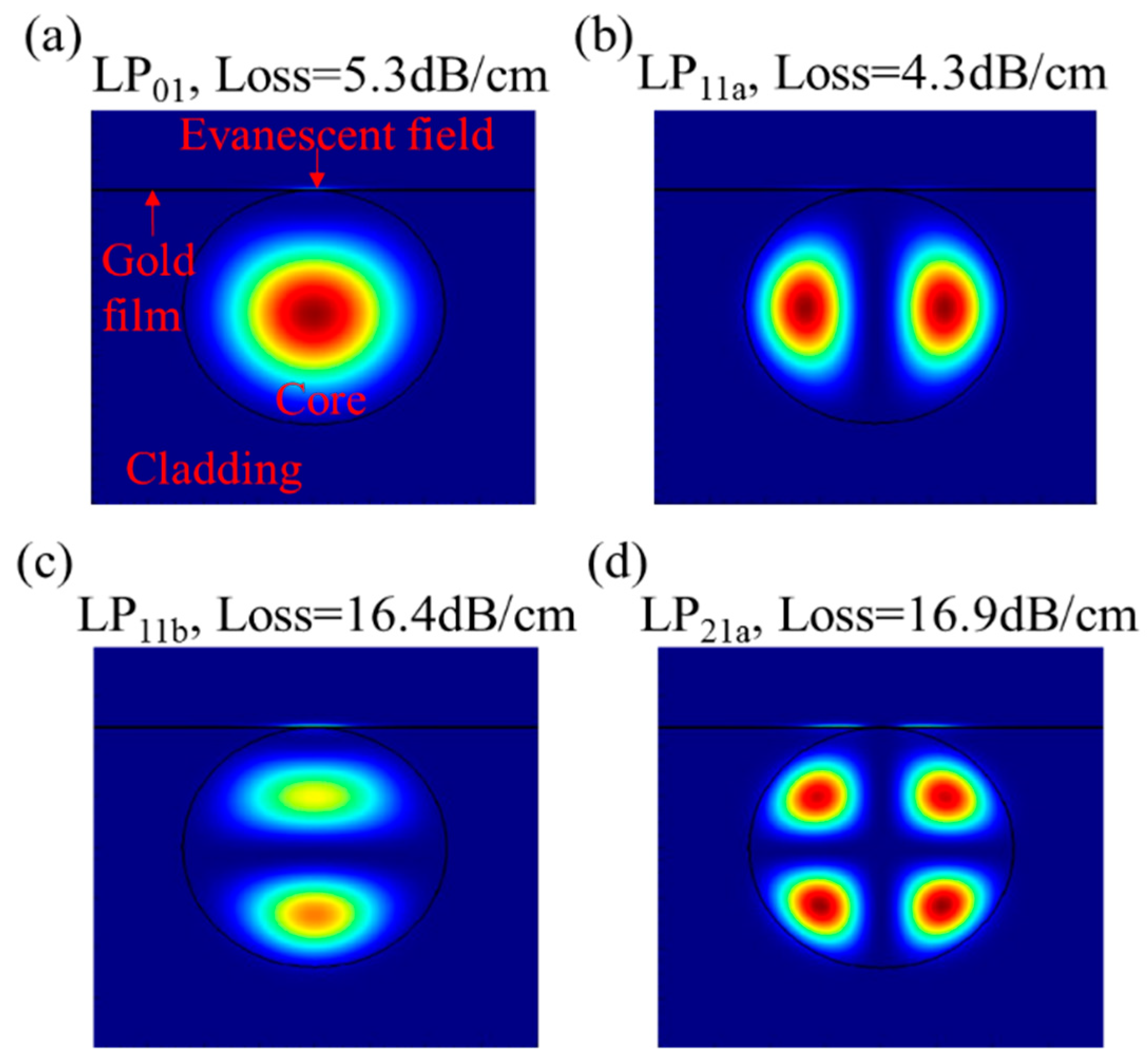

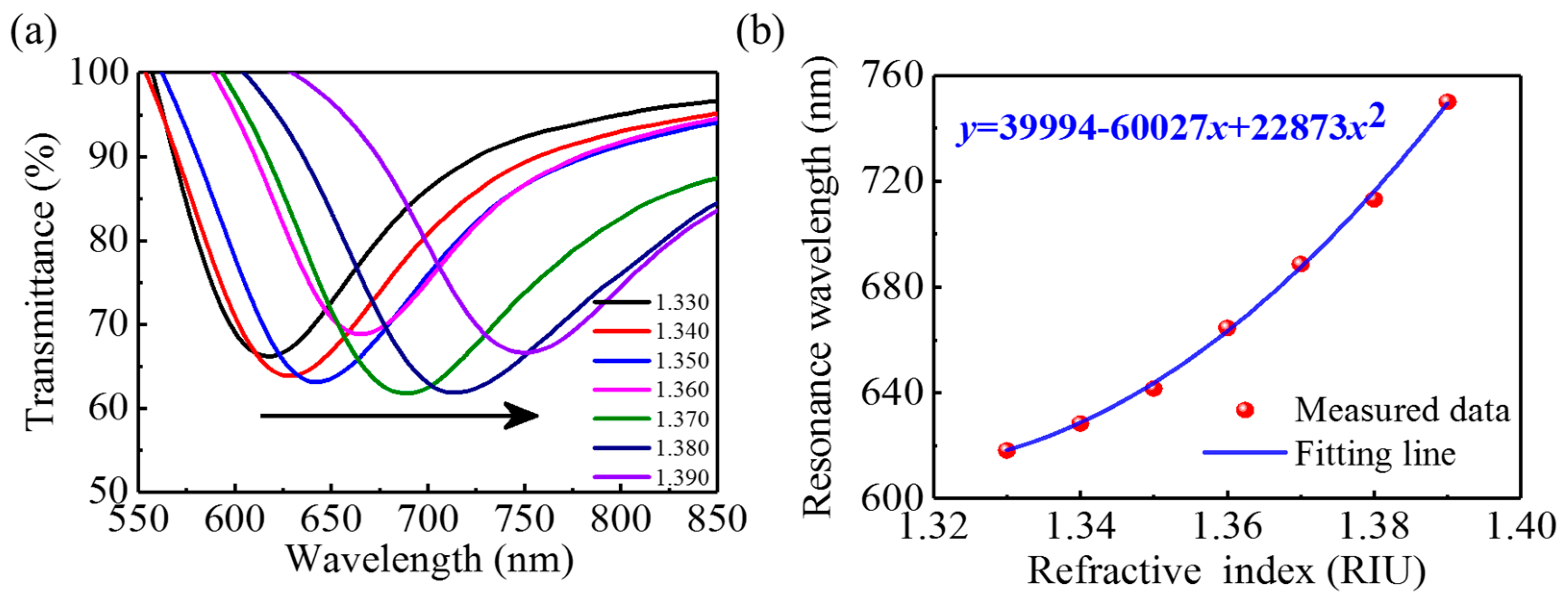
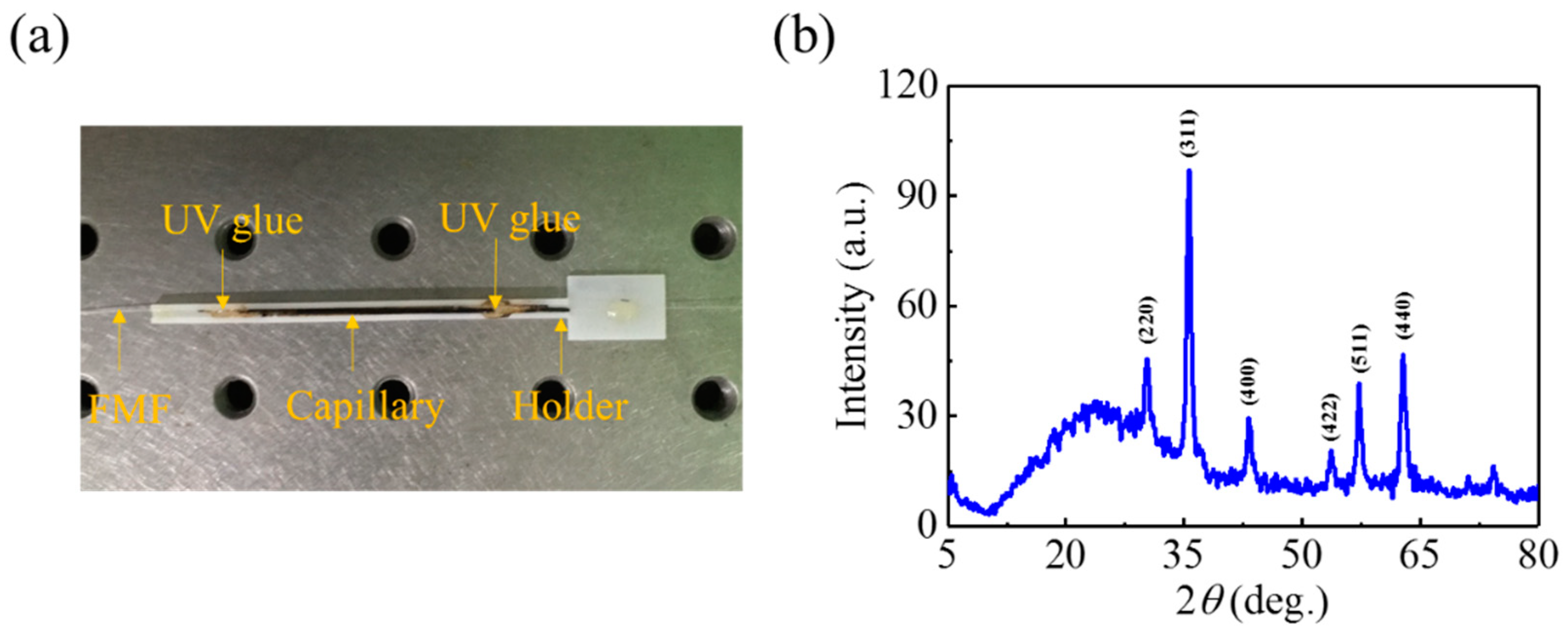

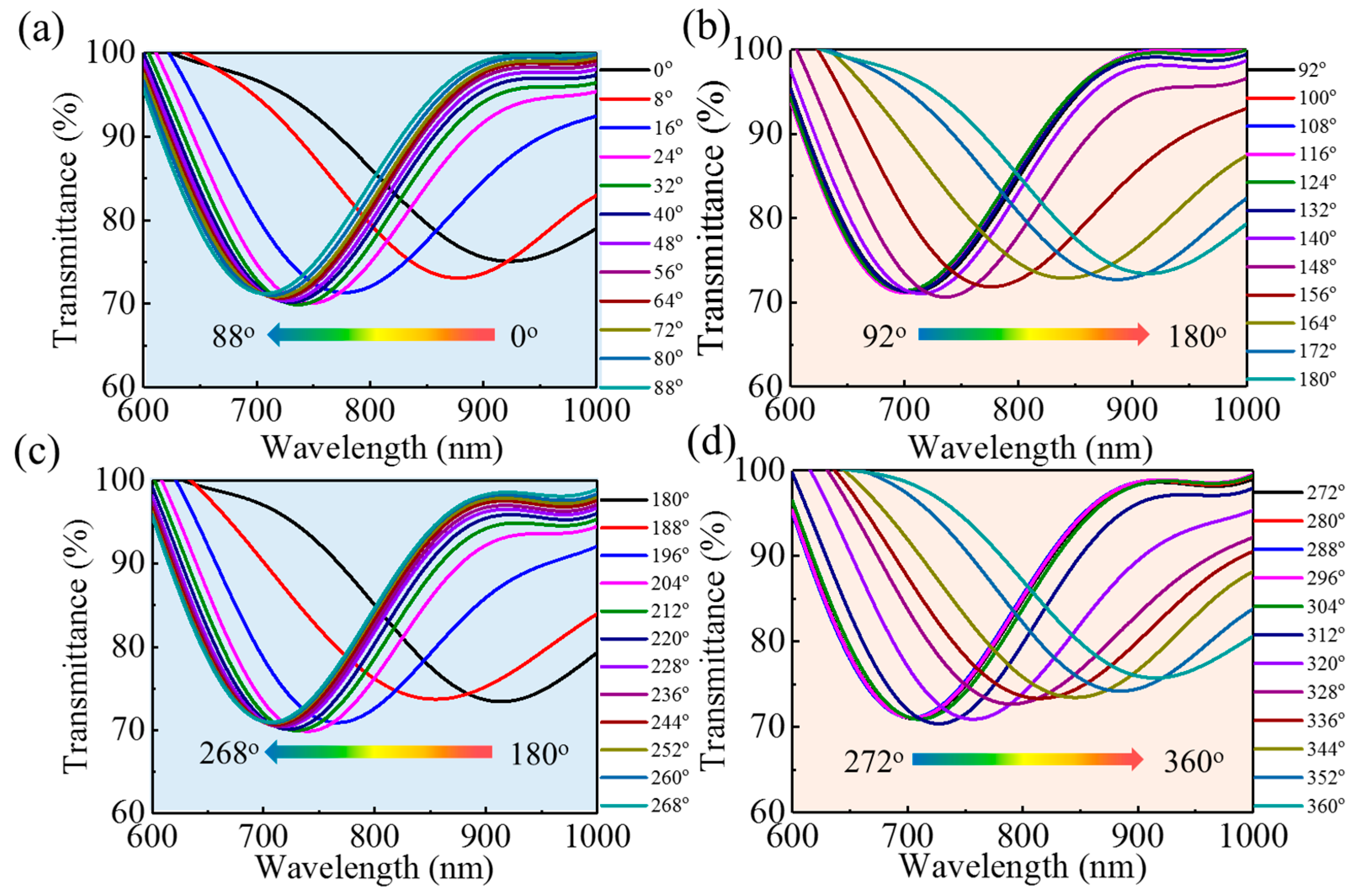

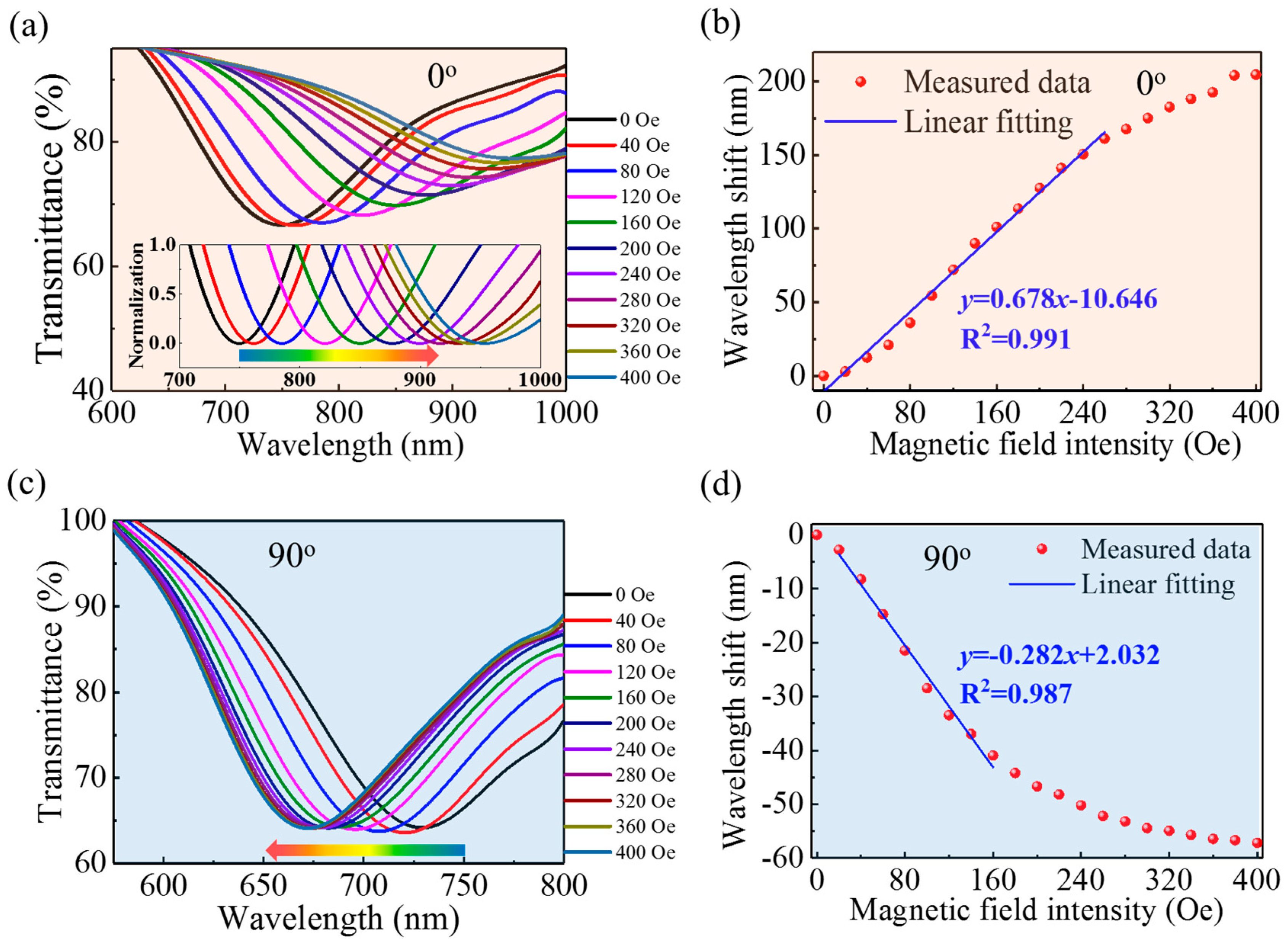
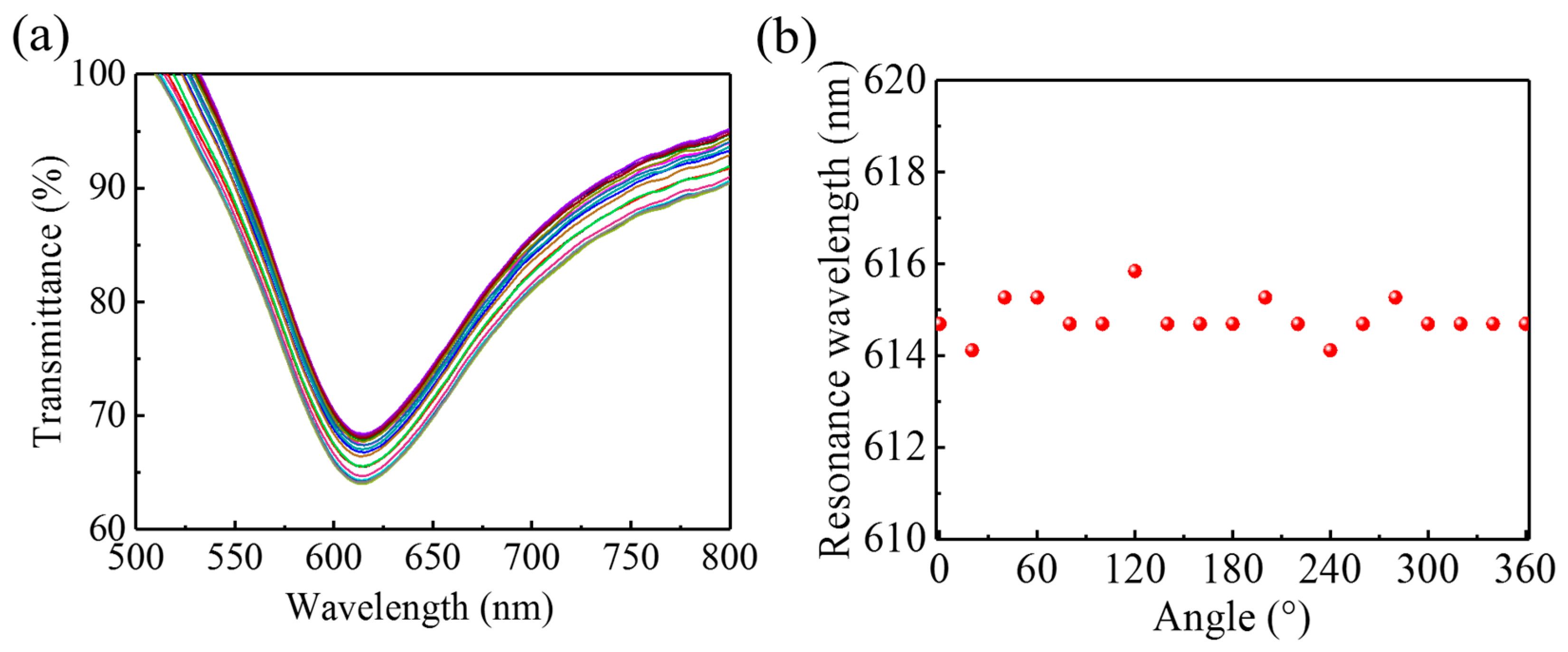
| SPR Scheme | Simulation/Experiment | Vector | Sensitivity | Reference |
|---|---|---|---|---|
| Prism | Simulation | No | 0.061°/Oe | [28] |
| Side-hole fiber | Simulation | No | 1.063 nm/Oe | [29] |
| D-shaped PCF | Simulation | No | 0.087 nm/Oe | [30] |
| Metal-dielectric-Metal | Simulation | No | 0.027 nm/Oe | [42] |
| Tapered fiber | Experiment | No | ~1.0 nm/Oe | [31] |
| No-core fiber | Experiment | No | 0.303 nm/Oe | [32] |
| Tilted FBG | Experiment | Yes | 0.18 nm/Oe 2 nm/° | [21] |
| Side-polished MMF | Experiment | Yes | 0.599 nm/Oe −5.63 nm/° | [33] |
| Side-polished FMF | Experiment | Yes | 0.692 nm/Oe −11.917 nm/° | This work |
© 2019 by the authors. Licensee MDPI, Basel, Switzerland. This article is an open access article distributed under the terms and conditions of the Creative Commons Attribution (CC BY) license (http://creativecommons.org/licenses/by/4.0/).
Share and Cite
Chen, Y.; Sun, W.; Zhang, Y.; Liu, G.; Luo, Y.; Dong, J.; Zhong, Y.; Zhu, W.; Yu, J.; Chen, Z. Magnetic Nanoparticles Functionalized Few-Mode-Fiber-Based Plasmonic Vector Magnetometer. Nanomaterials 2019, 9, 785. https://doi.org/10.3390/nano9050785
Chen Y, Sun W, Zhang Y, Liu G, Luo Y, Dong J, Zhong Y, Zhu W, Yu J, Chen Z. Magnetic Nanoparticles Functionalized Few-Mode-Fiber-Based Plasmonic Vector Magnetometer. Nanomaterials. 2019; 9(5):785. https://doi.org/10.3390/nano9050785
Chicago/Turabian StyleChen, Yaofei, Weiting Sun, Yaxin Zhang, Guishi Liu, Yunhan Luo, Jiangli Dong, Yongchun Zhong, Wenguo Zhu, Jianhui Yu, and Zhe Chen. 2019. "Magnetic Nanoparticles Functionalized Few-Mode-Fiber-Based Plasmonic Vector Magnetometer" Nanomaterials 9, no. 5: 785. https://doi.org/10.3390/nano9050785
APA StyleChen, Y., Sun, W., Zhang, Y., Liu, G., Luo, Y., Dong, J., Zhong, Y., Zhu, W., Yu, J., & Chen, Z. (2019). Magnetic Nanoparticles Functionalized Few-Mode-Fiber-Based Plasmonic Vector Magnetometer. Nanomaterials, 9(5), 785. https://doi.org/10.3390/nano9050785





